|
Friday, Jan. 11 – Off to Saigon
Damn – wide awake at 4 and raring to go. Got up at 5, did some yoga and took a shower and tried not to wake Bill – poor guy. At 7:30 we went to breakfast (and packed a sandwich to go, as usual).
Came back to the room to pack and do some journaling. At 11:30 we caught the shuttle to the airport – Changi. The van driver seemed confused and let us off at Terminal 3. We hurriedly found the Singapore Airlines check-in counter only to discover we were at the wrong terminal. We dashed off to catch a tram to Terminal 2. I was awestruck by Terminal 3 – didn't remember anything like that on our arrival. It was a shiny new palace with only a few people. There were 10-foot carved sculptures protected by armed guards and a huge rainforest with each tree individually potted. I wanted to stop and a take a few photos, but Bill was in a rush to get to Terminal 2. Terminal 2 was ordinary and certainly not photo-worthy. Later, Bill read in the Singapore newspaper that the terminal we dashed through cost 1.3 billion dollars to build and had only been opened for 2 days.
We checked in at Singapore Airlines, ate our sandwiches, checked our emails and then caught a 3-hour flight to Saigon. I tried to let the images of Singapore settle in my brain while to catching up on my journal – a losing battle.
We arrived in Saigon and had some trouble clearing passport control because the airlines didn't give us the arrival forms. We dashed over to another counter to find the forms and fill them out. These immigration guys in Vietnam take their jobs very seriously. I was panic stricken and mouth-breathing. However, we made it through and found our smiling guide, Thang, holding a sign with our names boldly displayed – What a beautiful sight that was.
Thang is a very sweet, serious guy and replies “thank you” to anything you say. Bill and I wanted to mellow out on our ride in from the airport. We had endured a lot of travel hassles that day, but Thang insisted on giving us a 45-minute talk on Viet Nam. We remembered most of the stuff from our visit in 2002 so we just nodded politely. We finally got to our room at the Oscar Hotel and settled in. I put a roll of toilet paper around the bathroom faucet to remind me not to drink the water or brush my teeth with it – We're not in Singapore anymore and we don't want to get sick!
At 7:00, we headed for a Tiger beer on the Garden Rooftop Bar at the classy old Rex Hotel just a block from the Oscar. I'm surprised we remembered it – a great spot looking down at a park with a statue of Uncle Ho holding a kid in his arms. The night breeze and the cool Tigers made life worth living. I looked up at the new moon and thought of my good friend Arlene who loved the tiny little sliver of a moon. It almost made me cry because Arlene died some years ago and I still miss her. (Seems like she's always popping in with the new moon). My sleep deprived brain was on the edge.
We walked to a restaurant close by. Crossing the streets here is very dangerous and not for the faint of heart. Bill was holding my hand as we dashed between the mass of vehicles weaving in and out. (Our palms were sweating!) I kept chanting my mantra – “Please don't hit me … please don't hit me …” Some locals (and even a Tourist policeman) took pity on us and helped us across the major intersection. The key is to keep a steady, predictable trajectory and somehow, everyone seems to adjust.
We made it to the restaurant -- The Viet Nam House. It was classy and elegant and the food would have been wonderful if it had been served hot, instead of luke warm. We got back to the room about 8:30. Bill read through my journal, making some edits, while I lay comatose on the bed watching Russell Crowe killing and slashing in “The Gladiator” on HBO.
I miss squeaky clean Singapore – but love the exotic scenes in Saigon and the cheap prices. This is about the only place that the dollar is worth something.
Saturday, Jan. 12 -Saigon
GOOD MORNING VIETNAM! Bright and sunny and fresh in the morning, but a hot, humid day in store for us. We enjoyed our breakfast - much better than the food served in our Singapore hotel. We ordered our omelets and then dashed to all the other food stations selecting our favorite breakfast fare.
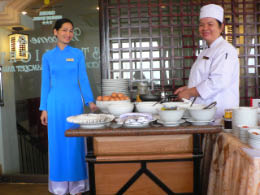
Omelet maker and hostesses to greet us at breakfast |
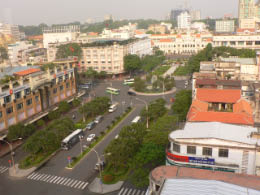
View from our rooftop hotel breakfast room |
We met Thang, our happy guide, in the lobby at 9, right on time. You can always count on the Vietnamese to be there. Our driver (who spoke very little English) was also there to greet us in the comfortable air-conditioned van with chilled bottles of water waiting.
| Meet Thang, our guide
Thang is always smiling. He's been a guide for nine years. Married for 4 years, he has no children, but looks forward to fatherhood. He's Catholic and his family fled to Saigon in 1954 after the French were defeated at Dien Bien Phu. He's proud of his country and capitalistic system where the people can prosper and buy goods. He's also proud of the huge population boom. I liked his gentle nature – had a calming influence on me. I also appreciated all the information he wanted to share. (He stopped a few times to give coins to the beggars on the street.)
|
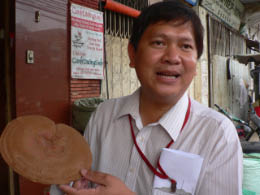
Thang, our guide |
The Reunification Palace
Our first stop was the 1960's style Reunification Palace, formerly called Independence Palace. We visited there five years ago, but it was better this time with Thang, our personal guide. The Palace, designed by a Vietnamese architect, was built to replace the old France colonial style palace so the new, independent country could try to forget about the French 100 year colonial rule. The place served as South Vietnam's "White House" - but only three presidents were residents. The first one, Diem, was overthrown in a 1963 coup (backed by the U.S.) and taken to a church (along with his brother) and assassinated by South Vietnam Army soldiers. The second one, Thieu, abdicated in 1975, just before the fall of Saigon. The last President to occupy the Palace only served for 48 hours before the tanks rammed the Palace gates on April 30, 1975. He cut a deal to live quietly and anonymously somewhere in Saigon. No one knew where he was until his death when his son told his story.
We walked around the grounds scattered with tanks, helicopters, fighter planes and other major weapons of war. We saw the tank that stormed the palace gates on April 30, 1975, signifying the fall of South Vietnam. We also saw where bombs had dropped on the roof of the Palace by a South Vietnam jet piloted by a Viet Cong who had infiltrated the South Vietnam Army. We also saw the helicopter perched on its rooftop landing to take the president away. (I still remember the images with Walter Cronkite reporting on the day the palace was captured - "and that's the way it was.")
The rooms in the palace were preserved in their original funky modern, kitschy 1960's style. I kept expecting Austin Powers to appear and say, "Hey Baby." First we toured the welcoming rooms set aside for dignitaries. The President's welcoming room, the Vice President's, the first lady's -- all bright and gaudy, complete with symbols of power - dragon heads carved on the chair arms and a stuffed cheetah.
The family's upstairs quarters were modest - a two bedroom flat with living / dining area around an open-air courtyard. Not much from our standards. President Thieu's children had to share a bedroom.
We saw the president's office with the secret door (disguised by wood paneling) which lead directly to the underground bunker. We visited the president's library stocked with books - imagine that, presidents who can actually read. We stopped by the map room where the leaders hatched plans and kept track of troops and Viet Cong on large paper maps now yellow with age. Today's GPS has really changed the layout of the famous "map rooms" where leaders plotted war strategies.
The most interesting part of the palace was the nerve center in the basement. Old radio systems, teletypes and other "modern" technology operated by gadget geeks looked so harmless and simple compared to electronics of today. Also in the bunker was a small room with a bed for the president to take a rest from his war duties. (We had seen a similar setup in London where Winston Churchill directed the British war effort during the Nazi bombings of London.)
The palace was a beehive of activity - busloads of school children on field trips, a huge reception for business people here to invest in Vietnam's new capitalistic economy, and a smattering of men from our generation who were probably Vietnam war veterans on their own personal journeys. We spotted a lot of them all around Saigon.
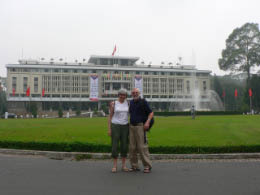
At the Palace |
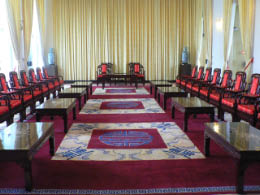 President's Greeting Room
|
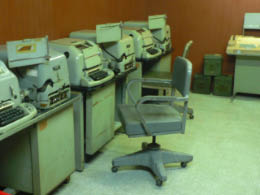
Latest in technology |
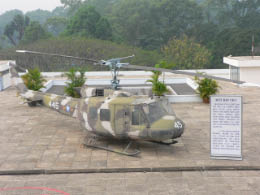
Helicopter to take President #3 away |
The Museum of Vietnamese History
In lieu of the War Remnants Museum (which we had seen in 2002), Thang took us to the Museum of Vietnamese History. It was a musty, run down old place. Without Thang's guidance, we would never have known about the amazing artifacts contained within the worn walls. There was a hodgepodge of things:
- A 2,500 year old bronze drum used for rain dances (When they weren't drumming for rain, they turned it over and used it as a wash basin.) Must be the trip for old bronze drums - we saw a bigger, more elaborate one from the same era in Singapore.
- Crude tools (e.g., axes, grinder stones) made from rocks by 500,000 year old pre-historic people (Thang said that Vietnamese inherited their funny toes from them.)
- A mummified woman who died in 1869 - always generates a lot of interest
- Items from the various dynasties - robes, canons, ceramics, jewelry, coins and a host of Buddha statues, dragons and incense burners.
Thang lead us to several displays depicting Vietnam's famous battle scenes. Little clay figures representing the soldiers set in dusty old glass cases told ancient combat stories of bravery and trickery. Some of my favorite stories were when the Vietnamese:
- Drove huge poles in the river's mud, then, at high tide, lured the powerful Chinese ships into the area. The tide went out and the large Chinese battle ships were stuck while the little, maneuvering boats attacked the ships from all sides.
- Painted faces on hundreds of coconut shells, added soldiers' hats, then floated the coconuts down the water in early evening (when one's eyesight is not as sharp). The invading Thai army used up all its arrows to attack the coconuts - then a small troop of Vietnamese soldiers attacked and beat the weaponless Thais.
- Arranged a royal marriage between the Vietnamese princes and the opposition King's son. The bride's family made all the arrangements, including the groom's wedding suit which was made with poisonous thread. The groom died shortly after the wedding.
- Cleared out the border villages so the invading Mongols had no food or shelter - The Vietnamese army moved all the villagers out of their villages and then burned down the houses, destroyed the crops and poisoned the water so that the Mongols would not be able to survive on the spoils of war. With nothing to feed the troops and only poison water to drink, the Mongols could not continue their invasion.
There were more stories of cleverness -- no wonder that little country survived invasions from China, Thailand, Japan, France and U.S. If our generals had studied the history of Vietnam fighting, they may have been reluctant to send in the troops.
Jade Pagoda
Next stop was the Jade Pagoda, built at the turn of the 20th century. We walked through a garden with a murky pond filled with sickly turtles right next to the entrance. Turtles are the symbol of longevity (but maybe not for the turtles). The temple had that "Apocalypse Now" feeling with it's eerie dark walls lined with carvings of gods and monsters and incense smoke drifting up to heaven. I saw a couple of women burning "fake red money," sending it along to their family who had passed on. Bill said, "I can't believe they have a fire going on such a hot day." Five years ago when we visited the temple without a guide and came away thinking it was just a smokey old place. Thang told us the temple is dedicated to Kim Hua, goddess of fertility. Women go there to conceive and mothers go there to ask Kim Hua to help them raise their children. There's also a god to education and a god to prosperity. The god to prosperity is in all Chinese temples. We observed the locals come to the temple, light an incense stick and stick it in an incense burner. They then proceed to the god that can help them with their current problem, whether it be fertility, money, happiness, safety, and so on. It only takes a few minutes and then they seem content and leave the temple, going back into their noisy, hectic everyday life.
We made a quick stop at Notre Dame, the France Colonial Post Office and the old Opera House - classic buildings built by the French. The old post office is fabulous - We ducked in to a buy a few postcards.
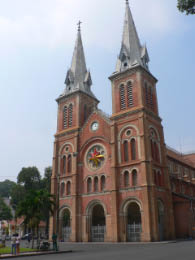
Notre Dame |
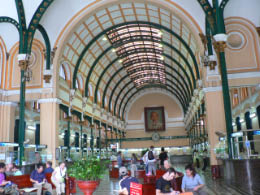
Inside the Old Post Office |
Thang left us on our own to shop at the massive Ben Thanh Market. The government stalls next to the entrance were quiet because of their fixed prices (and no haggling), but inside, the new capitalists made me crazy. They were the most aggressive salespeople - grabbing my arm to pull me into their little stalls. We did a brief walk through, repeating the words, "No thank you." The prices were cheap plus the shop owners were hot to bargain - but the shopping experience was not pleasant so we didn't buy anything. (We'd rather pay more and not be pushed into any purchases.)
We had a wonderful lunch at Pho 2000. The place was packed and steamy. We grabbed a seat across from two young Malaysian guys on a business trip. Pho means noodle soup and 2000 refers to the fact that it opened in 2000. We had a big bowl of flavorful chicken and vegetables and noodles for only a couple of dollars. Hanging on the walls were large photos of Bill Clinton and Chelsea eating at the Pho 2000. Clinton is very popular in Asia and has certainly covered the territory.
We met Thang and our driver at 1:45 to see the rest of the city. It was wonderful having an air-conditioned van with cold bottled water waiting - a great way to see a lot of things with little hassle. From my window I saw happy, colorful scenes and some not so appealing - spitting and public urination. Most of all I saw an unrelenting stream of motorbikes, each carrying two or three people and flowing through the streets somehow avoiding collisions. Unlike five years ago, almost all the riders wore helmets. A law requiring helmets went into effect last month and the citizens got onboard right away.
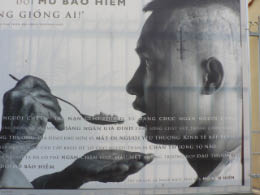
Street Poster - wear your helmets, or be hand fed |
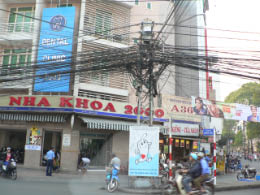
Electrical, phone wires always overhead |
We drove to Cholon - Saigon's Chinatown. Established in the 1900's, it never assimilated into Saigon's culture. The signs are in Chinese, the people are Chinese and don't venture out. We drove by a maze of temples, shops and houses tucked away. In the 1900's, Cholon was a hotbed of opium dens and houses of prostitution. The opium dens have since closed, but in the 1960's, drugs were big draw. A large number of American soldiers went AWOL and headed for Cholon. Right before 1975, the American government offered amnesty to any AWOL soldier hiding out. Story goes that only one dazed and confused GI stumbled out to turn himself in.
Thang walked us through Binh Tay Market - a vast wholesale market that sold every kind of item. No one harassed us to buy - They were busy in their closet-size stalls, packed from floor to ceiling, making deals with middle people. It was a hub of activity with sights to boggle the mind. Once the deal was done (with pencil and paper - no computers), the goods were piled high on motorcycles (or bikes or any means of transportation) and hauled away - quite a distribution center.
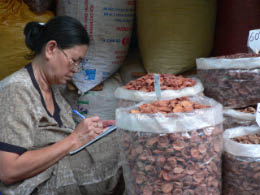
Crunching numbers without a computer |
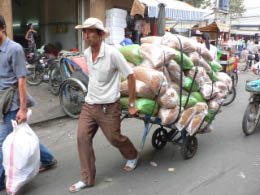
Hauling the goods away |
Thang then walked us through blocks of Chinese medicine shops that resembled old fashioned pharmacies with beautifully carved counters, drawers and shelving. The smells were exotic. There were jars of snakes, dried seahorses and other odd assortment of items. Business was good -- people were waiting in line to have their items weighed and wrapped in brown paper. Thang pointed out dried artichoke stems and a weird type of dried banana that had seeds on the outside of the peel. He told us that these dried seeded bananas are used to treat diabetes. Thang also showed us the Chinese Viagra - dried deer penises, selling for 20 bucks a pop.
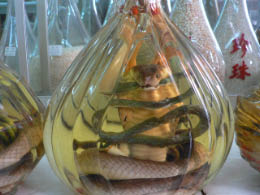
Snake in a bottle |
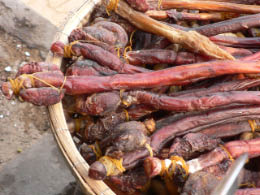
Deer pensis |
Back on the road, only two more temples and we were home free. We stopped at Thien Hau Pagoda (or Lady Temple), dedicated to the heavenly goddess of the sea. It was originally built in 940 A.D. with remodeled over the centuries. After their long, treacherous journey from China to Vietnam, travelers would come to this temple to give thanks to the goddess. Legend has it that the people would come to visit a psychic lady who hung out at the temple. She could predict the weather and guarantee them a safe voyage (for a fee, of course). I really liked this temple with its massive red pillars and spooky carvings with huge coils of incense hanging over the central courtyard.
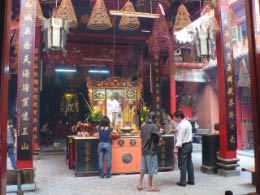
Lady Temple |
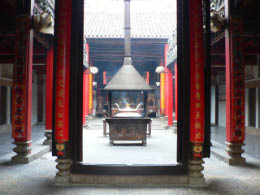
Lady Temple |
The main thing I remember about the next temple, Giac Lam Pagoda, was the long line in the ladies room. There was also a small pond overpopulated with huge fish, called elephant fish, struggling to survive. Inside, a monk was beating a drum and a gong, adding to the ambience.
We got back to the hotel at 4:30 and had a beer in the hotel lobby bar. It was a fascinating day. We went to the room to shower and cool off and then walked to the Quan An Ngon restaurant (138 Nam Ky Khoi Nghia). Bill had found it in our travel guide. We passed by a little girl sitting alone on the dirty sidewalk. She was about Zion's age and very poor. The scene broke my heart - all children should have happiness as their birthright.
I put the image out of my mind once we arrived at the restaurant. It was Saturday night and the place was packed mostly with young families. It didn't take very long to be seated at a table we shared with some more Malaysian guys here on business. They said they come to work on oil fields outside Saigon. They were engineer types, but very friendly. When they left, a Vietnamese family of three joined us. Their darling little 5-year old daughter was so good and enjoyed her meal - as did the rest of us. This place is the real deal - Bill really scored when he found it. (However, the spicy mint leave tucked into my spring roll gave me a jolt.)
Back to our room to work on my journal (while Bill reads his book The Kite Runner), then lights out to do my personal battle with insomnia.
Sunday, Jan. 13 -Saigon
About 8:30 Sunday morning we set off to explore the city on foot and on our own -- quite a different experience from yesterday's pampered tour. We headed down to the wharf shoeing away motorcycle taxis. This is not a walking city and it's odd to find us Waspy tourists take to the streets - and for good reason. The streets we followed seemed especially hostile to walkers. Dodging vehicles and walking through dirt and ruble, we finally found our way across the Ben Nghe Canal to our first destination - The Ho Chi Minh Museum.
Ho Chi Minh Museum
The Ho Chi Minh Museum is housed in the "Dragon House Wharf" - a 19th Century building located where Ho Chi Minh (A.K.A. Uncle Ho) set sail for Europe. There was a 1930's, WPA-style statue of young Ho looking out to sea. It was very hot with little breeze and the old building was in disrepair. Luckily we had learned a lot about Uncle Ho from our last visit - a most intriguing guy - a regular self-made revolutionary. He was born in 1911 in a little village. (Nguyen Tat Thanh was his given name.) He must have been quite a guy. He died on September 2, 1969 and the country still mourns his lose.
The museum was like searching through an old, disorganized scrapbook of Ho's life. Black and white photos told the essences of his life - here's Uncle Ho attending a communist party meeting in Paris, in the Congo, in Germany, in Russia and on and on. Here's Ho training the V.C., celebrating with the children, watering his garden, meeting world leaders. He read, he wrote, he designed his own house (we visited there in Hanoi in 2002). How did he do it all and still manage the revolution! The man intrigues me. Also intriguing to us were the 3 or 4 ladies (in their 70's) who approached us at different times while we were in the museum to shake our hand and bow. A wedding party was gathering outside on the grounds. The bride was gorgeous - the groom looked wilted.
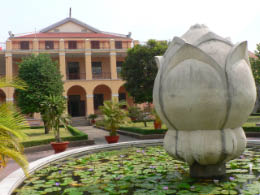
Ho Chi Minh Museum |
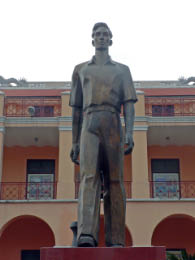
Young Ho Chi Minh, ready to set sail |
We shoed away a few more motorcycle taxi drivers and made our way to the Backpacker's district. We were on a quest to find the Ly Ly Hotel and say "Hi" to Van, the woman who took such good care of us in 2002. We found the place, but no Van. Through a translator, we learned that she got married and moved away. Good for her. When we met her, she was in her late 30's. She's a sweet person - hope her husband is a sweet guy.
We walked around the corner and had lunch at Allez Boo (187 Pham Ngu Lao) - fresh and tasty and cheap. We finished at 12:30. Next on the agenda was the War Remnants museum, but it didn't opened until 1:30. We had an hour to kill so we decided to walk to the museum and absorb even more street theatre.
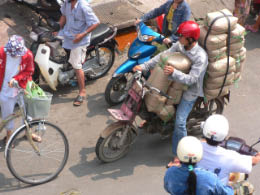
Traffic everywhere |
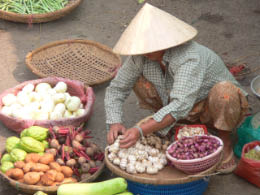
Sidewalk markets
|
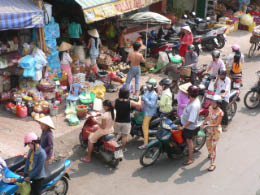
Teaming Masses |
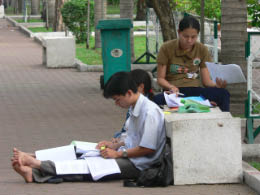
A walk in the Park - students studying |
The War Remnants Museum (formerly War Crimes Museum)
Five years ago the museum left us sad and angry and churned up feelings of the Vietnam war. Don't know why we wanted to go through that experience again, but here we were, reliving that terrible period. The museum is in a run down building and the displays hadn't changed much. Tanks, planes, weapons, bombs and all sorts of war machinery were parked on the outside grounds.
One part of the museum was an exact replica of the "tiger cages" at the infamous French colonial prison of Condao. It was used to house and torture locals who were like tigers, too spirited for colonial rule and needed to be controlled. In one room there sat a guillotine which was taken around the provinces to publicly decapitate Vietminh resistance fighters from 1900 to 1950.
The rooms inside the main museum were packed with Westerners. It was hot (no air conditioning) and stifling. There were about 5 rooms of photos - most of them made you winch. Photographs of biological warfare - victims of Napalm and children deformed by agent orange. (There were even a couple of badly deformed fetuses in a jar - but I didn't spend much time there.) There were atrocious pictures of war crimes - VC being shot, My Lai Massacre and other assorted horror scenes. (Wonder what the museum in Guantanamo will display.) There were simple hand lettered posters listing the facts about the American War - number of casualties, etc. A few photos of Jane Fonda were mixed in with the label "a warm hearted American." One room was devoted to some of the photo journalists who died during the war. I looked at their young faces and at the amazing photos they took - so very sad. There were photos of LBJ and Nixon, both looking cocky and greeting the troops. They were the real villains while our soldiers, their soldiers, and the collateral damage (farmers, families labeled Viet Cong) were the pawns. Last time we were here in 2002, we were saddened by the images, but came away hoping that maybe we had learned our lesson and that wars were a thing of the past - that was before Bush led us into another long, stupid quagmire - with suffering all over again. We'd seen enough. Our emotions and the heat had beaten us down. We hired a taxi to take us back to the hotel. We'd walked about 10 miles - a tough, watch-out-for-your-life 10-miles - so a taxi ride was well deserved.
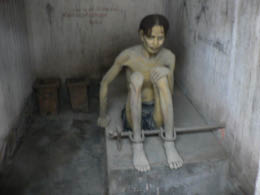
Tiger Cages |
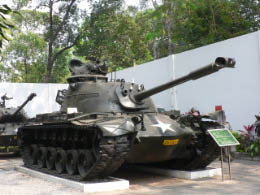
Captured American Tank |
We stopped for a cold Tiger (also well deserved) in the lobby bar of our hotel, then went up to the room to relax before dinner. Bill made reservations at The Lemongrass Restaurant (4 Nguyen Thiep), a lovely, quaint restaurant just around the corner from our hotel. (The place was completely booked the two nights before so we were happy to get reservations.) I had a shrimp dish and Bill had a seafood kebob - and then we shared a flan for dessert - a delightful dinner.
Back to our room to proofread the journal, pack for tomorrow's flight to Cambodia and mellow out! |











